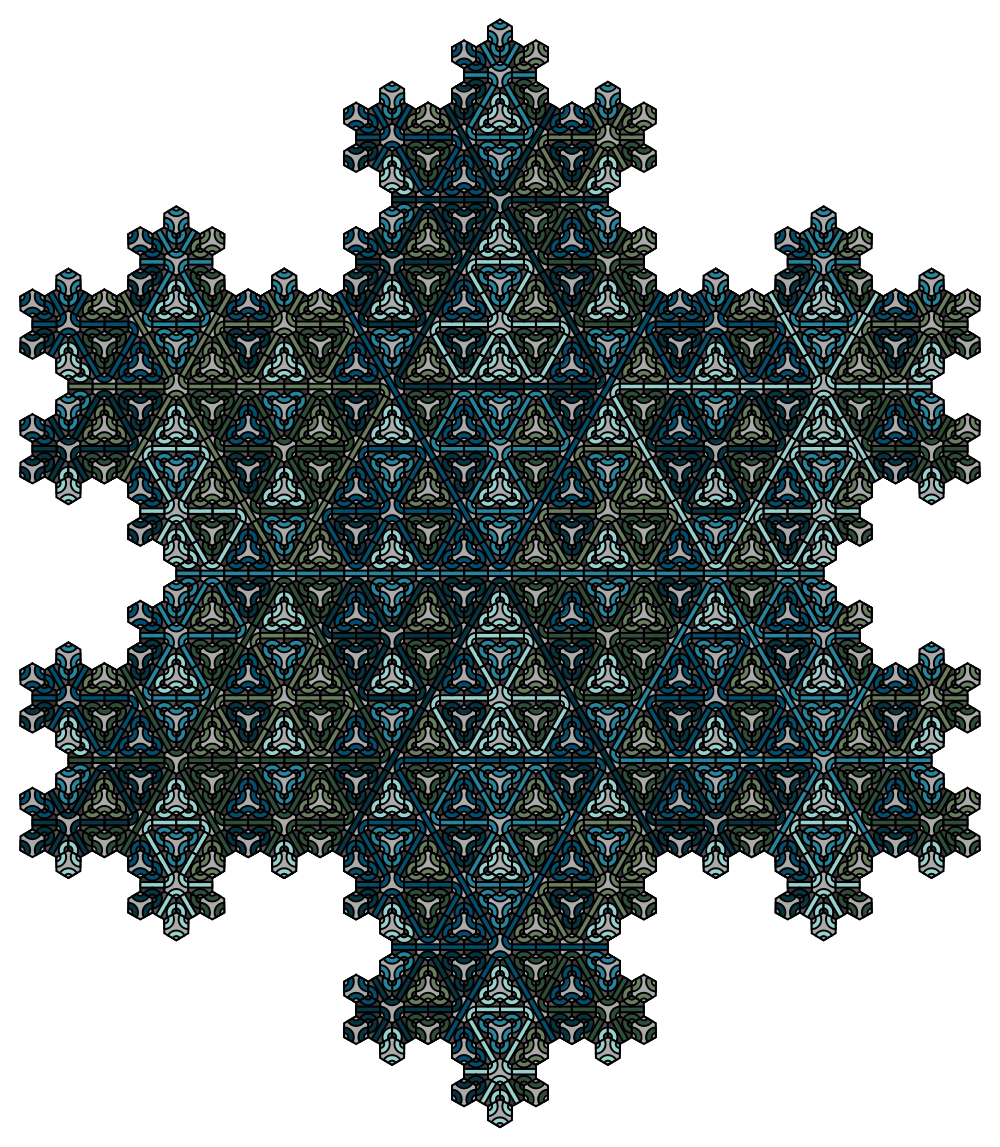
The blue tiling is a limit periodic tiling and a substitution tiling, with simple permutation transformation properties at all orders of magnitude. In some ways it is a relative of the viererbaum or quadtree tiling. The colors in the blue palette are sampled from a digitization of Picasso's famous "The Old Guitarist".
Colors
bgRep = {
0 -> Lighter@Gray,
x_ /; EvenQ[x] :> Darker@Gray,
x_ /; OddQ[x] :> Darker@Darker@Gray
};
colRep = {
a -> RGBColor[38/255, 132/255, 157/255],
b -> RGBColor[3/255, 78/255, 109/255],
c -> RGBColor[6/255, 52/255, 65/255],
d -> RGBColor[152/255, 208/255, 205/255],
e -> RGBColor[46/255, 78/255, 57/255],
f -> RGBColor[105/255, 126/255, 95/255],
"?" -> Yellow
};
Basic Tile Geometry
HexagonStar = {Cos[# 2 Pi/6 + Pi/6], Sin[# 2 Pi/6 + Pi/6]} & /@
Range[6];
Annulus2[o_, n_, c_, bg_] := {c,
Disk[o + {Cos[n 2 Pi/6 + Pi/6], Sin[n 2 Pi/6 + Pi/6]}, .7,
{(n + 2 + 1/2)*2 Pi/6, (n + 4 + 1/2)*2 Pi/6}], bg,
Disk[o + {Cos[ n 2 Pi/6 + Pi/6], Sin[n 2 Pi/6 + Pi/6]}, .3,
{(n + 2 + 1/2)*2 Pi/6, (n + 4 + 1/2)*2 Pi/6}]
}
Bridge[o_, n_, c_] := {c,
Polygon[o + # & /@ (RotateLeft[HexagonStar, n][[{1, 2, 4, 5}]] /. {
a_, b_, e_, f_} :> {3/10 (b - a) + a,
3/10 (a - b) + b, 3/10 (f - e) + e,
3/10 (e - f) + f})]}
DepictHexagon[o_, i_, bg_, ct_, cb_, cc_] := {bg, EdgeForm[Thick],
Polygon[o + # & /@ HexagonStar],
MapThread[Annulus2[o, #1, #2, bg] &, {{i, i + 3}, {ct, cb}}],
Bridge[o, i, cc]}
DepictHexagon[o_, i_, bg_, c_] := {bg, EdgeForm[Thick],
Polygon[o + # & /@ HexagonStar],
Map[Annulus2[o, #, c, bg] &, {i, i + 2, i + 4}]}
Generators
VertLabels[x_] := x /. {
0 -> {a, b, c, d, e, f},
y_ /; EvenQ[y] :> {c, f, e, b, a, d},
y_ /; OddQ[y] :> {e, d, a, f, c, b}}
hexRep = {
T[o_, i_, j_, cu_, cd_, cc_] :> {
T[3 o, 0, j, cu, cd, cc],
MapThread[
T[3 o + Sqrt[3] {Cos[#2 2 Pi/6], Sin[#2 2 Pi/6]}, #2, #2 +
1, #3, #4, #1] &,
{RotateRight[{cu, cc, cd, cd, cc, cu}, j],
Range[6], VertLabels[i], RotateRight[VertLabels[i]]}],
MapIndexed[
T[3 o +
3 {Cos[#2[[1]] 2 Pi/6 + Pi/6],
Sin[#2[[1]] 2 Pi/6 + Pi/6]}, #2[[1]], #1] &,
VertLabels[i]]},
T[o_, i_, cc_] :> {
T[3 o, i, cc], MapThread[
T[3 o + Sqrt[3] {Cos[#1 2 Pi/6], Sin[#1 2 Pi/6]}, #1, #1 +
1, #2, #3, cc] &,
{Range[6], {a, b, c, d, e, f},
RotateRight@{a, b, c, d, e, f}}],
MapIndexed[
T[3 o +
3 {Cos[#2[[1]] 2 Pi/6 + Pi/6],
Sin[#2[[1]] 2 Pi/6 + Pi/6]}, #2[[1]], #1] &,
{a, b, c, d, e, f}]}};
depictRep = {
T[o_, i_, j_, cu_, cd_, cc_] :>
DepictHexagon[o, j, i /. bgRep, cu /. colRep, cd /. colRep,
cc /. colRep] ,
T[o_, i_, c_] :>
DepictHexagon[o, i, 0 /. bgRep, c /. colRep]
};
Print
Graphics[
T[{0, 0}, 2, 1, b, c, a] /. hexRep /. hexRep /. hexRep /. depictRep,
ImageSize -> 1000]

Screencapture

It would also be possible to construct this tiling using the same sort of algorithm as in the Wolfram Demonstration above. That programming could lend itself quite naturally to interesting animations taking advantage of invariance under scale transformation / inflation. I haven't had the time or interest lately, maybe others will?